Peter MALONE
Saturday, 18 September 2021 19:43
Satan Bug, The
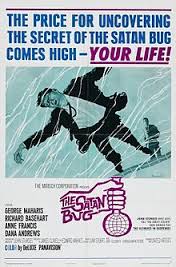
THE SATAN BUG
US, 1965, 114 minutes, Colour.
George Maharis, Richard Basehart, Anne Francis, Dana Andrews, Edward Asner, Simon Oakland.
Directed by John Sturges.
The Satan Bug is what is called a Doomsday thriller – with the touch of the apocalyptic as the population of the world could be eliminated by a deadly bug. After a robbery in a laboratory, it is thought that a bug would cause infections. However, it is later discovered that a more virulent form has been taken – the Satan Bug.
This is a race against time as the criminals try to use their bug and the military and the authorities try to stop them. Richard Basehart is the mad villain – a young Edward Asner appears as one of his cohorts. George Maharis is the hero with Dana Andrews as a general and Anne Francis as his daughter. There is a fair amount of tension generated in the film.
The film was directed by John Sturges who had made a number of standard films but in the late 1950s made The Gunfight at the OK Corral and moved on to such films as The Magnificent Seven and The Great Escape. This film was made soon after The Great Escape. It is based on an Alistair McLean? novel – and Alistair McLean? novels became popular in cinema from 1969 with versions of Where Eagles Dare as well as Ice Station Zebra (again directed by Sturges). The novel was adapted by author James Clavell (Taipan, Shogun) who also directed a number of films including at this time To Sir With Love. He also made the war of religion film, The Last Valley.
1. Was this good science fiction? Why? How entertaining was it? What was the purpose of making this science fiction film? In the mid-sixties?
2. Was it an effective thriller? An effective mystery?
3. The atmosphere of germ warfare and experimentation, what impact does this make on an audience?
4. The morality of experimentation for germ warfare? Has anyone the right to experiment in this area? What impression does this make on an audience? For America to be developing germ warfare techniques?
5. The villain in this film was mad. He wanted to destroy people he did not agree with by germs. How was he a sym bol of power, government, who do the same thing? It is easy to condemn a single mad individual. but not a government. Was this well developed in the film?
6. Did you like the hero? Was he just a film stereotype or was he a real person? His being tested for loyalty? Did you agree with the method he used for detection?
7. The role of the general and his daughter in the film? How necessary were they? What purpose did they serve?
Was the daughter merely romantic?
8. How plausible wax this situation? Could a millionaire madman effect the kind of substitution the villain did here?
Could he go so long without being detected? To get such power? What really motivated him?
9. The impact of the epidemic on Florida that it really happened? Then the threat to Los Angeles? How frightening
is this to think about? How frigthening for an American audience watching in America?
10. The final helicopter ride and the suicide of the villain? Was this too easy a solution for the problem raised in the
film? Or was it a fitting and realistic ending?
11. How entertaining are such warning science fiction films?
Published in Movie Reviews
Published in
Movie Reviews
Tagged under
Saturday, 18 September 2021 19:43
Saskatchewan

SASKATCHEWAN
US, 1954, 84 minutes, Colour.
Alan Ladd, Shelley Winters, J. Carroll Naish, Robert Douglas.
Directed by Raoul Walsh.
A pleasantly routine western from Universal Studios in the fifties. It was directed by veteran Raoul Walsh, who had made so many action adventures (especially with Errol Flynn) at Warner Bros in the forties and fifties.
Alan Ladd is generally a sombre hero and this is the case as he portrays O'Rourke of the Royal Mounted Police. Shelley Winters in her more glamorous days is the conventional heroine. The film shows something of the background of Canadian history and is a tribute to the Royal Mounted Police. Its distinction is its colour photography in authentic locations.
1. An entertaining western? Its presentation of Canada and the United States? The Royal Mounted Police? Indians? Life and difficulties on the frontier?
2. Audience expectations of this kind of western? The conventions of the landscapes, the frontier, Indians and their banding together, the attacks on the whites, whites' aggression and defence of themselves? Heroism? misunderstanding? Romance? How well presented in this film? conventionally?
3. The importance of the colour photography in authentic locations? An authentic atmosphere? The typically rousing score? The special effects? especially for the sieges, the escape of the mounted police?
4. The film purporting to be based on fact? The history of Canada? Attitudes towards the police, the whites, Indians? The credibility of the clash of red and white? The attempt at giving some dignity to the Indians? Their desire for peace? The heroic sub?plot about O'Rourke, the romance and the heroine accused of murder? A satisfying plot for this kind of western?
5. Alan Ladd as hero - sombre, stolid type? his being half-brother to the Indian? His place in the Mounties? The attitude towards authority? and his leading the mutiny? His ability to guide the men in their escape from the Indians? His falling in love with the heroine? Her being accused of murder? The narrow escapes? The imprisonment of the men in the fort? His going to discuss with the Indians - his not being listened to? The final escape and his being vindicated? The happy ending? The stylised tribute to the Mounted Police in him?
6. Shelley Winters as heroine? surviving the Indian attack, her falling in love with O'Rourke, her being pursued by the sheriff and his vindictiveness, the truth about the death? Her participation in the adventures? In O'Rourke's escape? The happy ending?
7. The presentation of the Indians? friendly tribes, the Sioux and Sitting Bull? The oppression by the military? The taking away of arms? The reactions of the younger Indian? the pursuit of the Mounties? The fights? The final confrontation and the help of O'Rourke? The making of peace? A more just point of view on the Indians and their relationships with the whites?
8. The military? the letter of the law, official viewpoints? The taking away of arms from the Indians? Forcing them into reaction against the whites? The going by the book? The mutiny? Imprisonment? The final vindication?
9. The range of men on the trek? the heroic Irishman, the hardworking soldiers, the vindictive sheriff? and his death? rounding out the conventional story?
10. How satisfying this kind of western? As an adventure? Popular glimpse at the past? raising of historical and social issues in the United States and Canada?
Published in Movie Reviews
Published in
Movie Reviews
Tagged under
Saturday, 18 September 2021 19:43
Saratoga Trunk
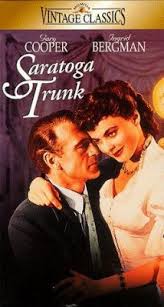
SARATOGA TRUNK
US, 1945, 113 minutes, Black and white.
Ingrid Bergman, Gary Cooper, Flora Robson, Florence Bates.
Directed by Sam Wood.
Saratoga Trunk is a 40s melodrama, an opportunity for Ingrid Bergman and Gary Cooper to act again together is they did in Sam Wood’s For Whom the Bell Tolls.
This time Ingrid Bergman is a young woman who returns from Paris to New Orleans wanting to wreak vengeance on her father’s family because of their treatment of her mother. She has a mulatto slave, played by Flora Robson, who won an Oscar nomination for this performance. However, she falls in love with a gambler played by Gary Cooper. They go to Saratoga Springs in New York State for the racing season – and her intention is to get a fortune.
Standard material, done with some competence because of the cast and direction by Sam Wood. Wood has the reputation of being a rather serious-minded director, especially from his later films which included King’s Row, Pride of the Yankees, Command Decision. However, in the 1930s he directed the Marx Brothers in A Night at the Opera and A Day at the Races as well as Goodbye Mr Chips.
1. Was this an enjoyable film? How typical of Hollywood film-making in the forties? As regards acting, style, production values and attitudes, sentiments?
2. How important were the personalities of the stars for the film and its impact? Does this seems as strong in retrospect?
3. How interesting a picture of the United States did the film give? Could it be taken as history? As a glimpse of the nineteenth century? As an insight into the southern states? Into the north? Into Texas and the kind of men it produced?
Its portrayal of rich and poorer classes? Of ambitions and pride? Of struggles and drive? Of success and values? Of the success of the people of the south? Was it an exploration of these values?
4. How central was Clio for the film? Its opening with her, her memories, and her visiting, the house, her background and time in France, her sense of ambitions, wealth and marriage? The portrayal of Clio on the make? Her style in New Orleans, in the streets, market, eating, at the restaurant, in church? The support she got from Angelique? from Cupidon? How did she change in New Orleans soclety? How much did Clint change her? Or did he just channel her ambitions?
5. How interesting a character was Angelique? As the brooding mamma? Her support of Clio? Her criticisms of her? Her loyalty? Could Clio be understood in her relationship with Angelique? How loyal was Cupidon? His role in the film? Audience response to his being a dwarf? Did this add his attraction? (Wan he too cute at times?) His role in the film later with Clint and the Saratoga Trunk war?
6. How typical a Gary Cooper role was Clint? The Texas background, the openness, the nonchalance, the gambling? Why was he so attracted to Clio? His attempts to understand her moods? His leaving her, supporting her in Saratoga? Did he love her all the time?
7. Comment on the portrayal of New Orleans society and its snobbery? Clio’s family and the attempted blackmail? Her shrewdness in winning?
8. How was Saratoga a symbol for her ambitions? What change did it make in Clio? Her support from Clint? From the women at the hotel? from her fiance? The style of her ambitions and her deceits?
9. How naïve was Clio? Deceived by her own image? The fact that her background was well known in Saratoga? The conflicts she experienced in Saratoga? With the fiance?
10. Was the Saratoga Railway War well built into the film or was it an added eytra for a spectacular climax? Were the issues well raised? The railway men and the clashes? Money and ambitions? parallel with the West for the railways? The drama of the two trains? The crash and the fight? Comment on the use of special effects for this.
11. What did the film have to say about truth, honesty, the future?
12. How real did the film seem? The reality of its incidents as a representation of the United States?
Published in Movie Reviews
Published in
Movie Reviews
Tagged under
Saturday, 18 September 2021 19:43
Saratoga
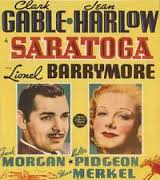
SARATOGA
US, 1932, 92 minutes, Black and white.
Clark Gable, Jean Harlow, Walter Pidgeon, Lionel Barrymore, Frank Morgan, Una Merkel.
Directed by Jack Conway.
Jean Harlow's last film. She had appeared with Clark Gable in a number of films including The Secret Six, Wife Versus Secretary and most significantly Red Dust. She died before completion of the film and a stand-in was used for some sequences and the screen play re-written for this.
The film is a blend of racing film and screwball comedy thirties' style. Jean Harlow has an unusual role - she is meant to be aristocratic (and is not entirely persuasive). Walter Pidgeon has the foil role to Clark Gable's con-man hero - they were to appear in Too Hot To Handle in similar roles a year later. The film is pleasant in its way but truncated in its form because of Harlow's death.
1. An entertaining comedy romance of the thirties?
2. The blend of the sporting film with screwball comedy? Carol and her aristocratic pretensions, romance with Hartley? Relationship with Duke? Romantic tangles, confidence trick tangles? Conventional material - more?
3. M.G.M. production values, gloss? Black and white photography, racing sequences? The stars?
4. The plausibility of the plot? credible characters, situations? For comedy? The blend of realism and contrivance?
5. Duke as hero? confidence trick style, man about town, relationship with Carol, victimising Hartley? The racing connections? Techniques? Friends? His taking in Hartley, confrontations and fights? Winning Carol? A typical Gable romantic hero? Symbol of the American type hero of the thirties?
6. Jean Harlow's performance as Carol? how credible with her aristocratic voice, romance with Hartley, connections in London? Her return? Her father? The clashes with Duke? Her support of Hartley? Changes of heart and helping Duke to trick Hartley? The finale?
7. Hartley as an aristocratic stooge? Walter Pidgeon's comic style? Love for Carol, business sense, clashes with Duke, his readiness to bet? His almost winning?
8. The contribution of the minor characters ? Carol's family,
Rosetta?
9. The racing sequences with the background of the bets and confidence tricks?
10. The comedy routines, the American romance symbolised by Gable and Harlow? The world of affluence for a thirties' audience? Now?
Published in Movie Reviews
Published in
Movie Reviews
Tagged under
Saturday, 18 September 2021 19:43
Sapphire
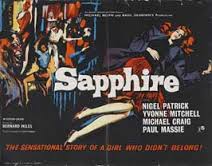
SAPPHIRE
UK, 1959, 92 minutes, Colour.
Nigel Patrick, Yvonne Mitchell, Michael Craig, Paul Massie, Bernard Miles, Olga Lindo, Earl Cameron.
Directed by Basil Dearden.
Sapphire was a very distinctive film of 1960 – winning the BAFTA award for best film. It is about racism in the United Kingdom. To that extent, it is as topical in later decades as it was in its time, given the variety of migrants, refugees and illegals coming into the United Kingdom for more than half a century.
This film is set in London, an investigation into the murder of a pregnant young woman who was of mixed race. Nigel Patrick and Michael Craig, very strong leading actors of the period, portray the police. There is also a very strong performance by Yvonne Mitchell who has the ability to create atmosphere of tension, even hatred. There is a good supporting cast with Paul Massie and Bernard Miles. Earl Cameron, a black actor of many British films of the period, appears as a doctor.
The film was directed by Basil Dearden. Dearden had begun the 1950s with films like The Blue Lamp and Pool of London, focusing on social issues. In 1952 he made The Gentle Gunman about Ireland and the IRA. After Sapphire he also made The League of Gentlemen but received great commendation for his film victim and Life for Ruth which raised issues of homosexuality as well as capital punishment in English society.
1. Was this an enjoyable fim? Its impact as a murder story, as a film about race relationships?
2. How successful was the film on the murder mystery level? The initial presentation of the murder, the line up of suspects, both white and black, the clues that were offered eg David's searching for the doll's leg, the detail of the police work and following up clues, the final confrontation of the murderer? Why are murder mysteries always interesting and absorbing?
3. What were the basic attitudes of the film on racism? On racism in general? On white attitudes towards black? Black attitudes towards white? The quick question of mixed blood and passing for white?
4. What did the film have to say about racism and hatred? The murder as one of hatred and the intensity of a racial hatred? Was this convincingly portrayed by the Harrises? (By any of the black characters?) How important was the personality of Sapphire in the film? The fact that she was only glimpsed dead or in photos? Our knowledge of Sapphire and changes, attitudes? Basic sympathy? The question of her pregnancy? The fact thaf she was black and passing for white? The importance of Dr Robbins first appearance? As an ordinary girl, unsuspecting, a student? the attitude of the Harrises in her passing for white? The attitude of the black characters in her passing for white? Why did they condemn her? Was she to blame in this? Why? The story of her discovery of being able to pass for white?
5. The importance of the Harris household for the impact of the film: as an ordinary English family, the nature of their bigotry, the effect on Mildred and the children, Mr Harris's ambitions for David, his answering for David and living his life? Mildred said to be like her father? The impact of Sapphire's revelation to them and their response? Their behaviour to Dr. Robbins? The impact of the truth on the whole family?
6. Did the film, make it credible that the shock about Sapphire would drive Mildred to murder? What kind of person was she? As portrayed in the film - her husband, children, father, ambitions for David etc?
7. Was David a credible character? As a suspect for Sapphire's murder? Being driven by his father and rebelling against him? His love for Sapphire and for the child? Balancing his love for Sapphire against his career?
8. The importance of the black characters, in the film ? the relationsnip between Sapphire and Slade, Slade’s bishop father, the Tulip Club and her dancing there, Johhny Fiddle and the dancing and his background of his being chased and fight from the time when Sapphire was murdered?
9. How typical of English police were the the Leeds? Hazard as efficient and ordinary? Learoid as ordinary? Their work as police? Their attitudes towards race questions? Learoid's automatic racism? His being put down by the doctor? His change of attitudes at the end? His relationship with Dr. Robbins?
10.The nature of black prejudice - Bishop Slade’s not liking Sapphire because she was part white? The black couple not helping Johnny Fiddle becauag he was black trash etc? Were the black characters presented too grimly or were they presented fairly?
11.Comment on the effectiveness of the clues, the locations, how did the whole story seem real? Was this important for audience impact?
12. The use of jazz and the rythms as backgrounds for the film? The talk about black personalities responding to rythms?
13. How satisfactory was the ending - was it too didactic? Or was it satisfying for this film?
Published in Movie Reviews
Published in
Movie Reviews
Tagged under
Saturday, 18 September 2021 19:43
Santee
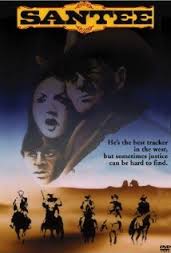
SANTEE
US, 1973, 93 minutes, Colour.
Glenn Ford, Michael Burns, Dana Wynter.
Directed by Gene Nelson.
Santee is a moderate western from the 1970s, an era when the western was losing its dynamism. The film was also a star vehicle for Glenn Ford, after his heyday in the 1940s and 50s and into the 60s when he was one of Hollywood’s most popular actors. The leading lady is Dana Wynter, who also had a brief star career during the 1950s. Michael Burns is a young lad whose father is killed and who becomes attached to the bounty hunter, played by Ford. Jay Silverheels (television’s Tonto) also appears in the cast.
The film is historically of interest in the technical sense, in that it was the first film shot on video. Thirty years later, so many films used digital photography to great effect.
1.A quality a Western? Its impact as a western, human drama?
2. How well did it use the conventions of the West of the time, places, situations on farms, towns, gangs? An atmosphere of the 19th century west?
3. Colour, location photography, music? The importance of the songs and the introduction during the film? The director and photographer as influenced by the style of Sam Peckinpah, with gore, slow motion, dramatic symbolism of aspects of the west?
4. The conventions of a vengance western; themes of venganceand peace, the role of the gunner, deaths and revenge, brooding about death for revenge? The picture of families, farms, towns, the menaceof gangs, the role of bounty hunters? These themed as part of the American heritage of the 19 th century? Influence of the present day?
5. The Initial focus on Jody; as a young boy, his being seen in the start, in the town searching for the letter? The impact of his fathers' death and the deaths of the others? Hostility towards Santee? His trying to cope, his feeling toward Santee, travelling with him and the reason for change? The impact of Santee's home? His liking for Valery and his liking him for Santee’s sake? The working with John Crowe, the exhilaration of the farm and the work? Fearing the story of Santee from John Crowe and the visual impact of the flashback for the audience and for Jody? His turning Santee into a hero, his being the equivilant of a son? The bond between the two? The humane quality and the way this was communicated to the audience?
6. Glenn Ford as Santee; the focus of the title on him, a man of the west, peaceful experiencing the violence of the gun, his brood, guilt, revenge? Motivations for being a bounty hunter and the way he exercised this job? The confrontation with Jody and the drawing out of affection and love for and equivalent son? The wisdom of the man? Their interaction as they travelled? Santee seen at home, peace, work, hopes? The tenderness of the bonds with Valery? The audience knowledge of the truth about his child and the effect of this, on response to Santee? To see his torment and guilt? The confrontations with the banners and his decision not to go? The death of the Sherriff and his still wanting to be peaceful ? The inevitability of the hunt?
7. The story and the effect of Jody, Jody pushing Santee to go a out and exercise the bounty hunter work ? Audience expectation of violence to erupt? Expectation of the death of Jody? The pathos of his bringing Jody’s body home to Valery?
8. How well portrayed was Valery as a woman of the West, her place, work, wife, grieving mother, bonds with Jody? The tenderness of the scenes between herself and Santee?
9. The character of John Crowe, his Indian background, his work on the farm? His contribution to Jody's growing up? The telling of the story and the visualising of the flash-back?
10. The portrayl of the Banner gang as typical gang of the west? Ugliness, ruthlessness, lack of morals? Cruelty and violence? Confrontations, the death of the sherriff? The west as a place where evil came in the form of gangs and had to be confronted for justice and peace?
11. Themes of peace and hopes for peace and what can be built on peace?
12. The people of the west, good and bad, the people of the town, outlaws?
13. The importance of the photography of landscapes of the west, their distinctive character, peole in this environment and how it affected them?
14. The violence of the west and the inevitability of its eruption? The surprise and creelty of violence? The atmosphere of grim fatality abotu the film? . How much hope in the ending?
Published in Movie Reviews
Published in
Movie Reviews
Tagged under
Saturday, 18 September 2021 19:43
Santa Fe Trail, The
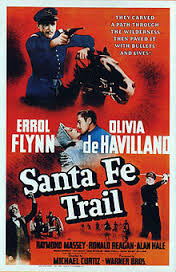
THE SANTA FE TRAIL
US, 1940, 109 minutes, Black and white.
Errol Flynn, Olivia de Havilland, Raymond Massey, Ronald Reagan, Alan Hale, William Lundigan, Van Heflin.
Directed by Michael Curtiz.
Santa Fe Trail was a big-budget Warner Bros western of 1940. It was directed by Michael Curtiz who had made a number of action films in the 1930s and was to achieve some fame in the 1940s winning an Oscar for directing Casablanca.
The film is an Errol Flynn vehicle, he stars as the civil war general Jeb Stuart, with his background from West Point. The film is of interest because of the friendship between Stuart and Custer and the fact that Custer is played by Ronald Reagan. (Flynn was to portray Custer at this time in They Died With Their Boots On.) Olivia de Havilland, who had appeared in a number of films with Errol Flynn, starting from Captain Blood in 1935 as well as They Died With Their Boots On, is Kit Carson Holliday. The young William Lundigan and young Van Heflin also appear in the cast.
Film critics complained that the film is not historically accurate – rather it is an imaginative western, portraying the friendship of Stuart and Custer as well as the build-up to the civil war, especially through the character of John Brown, played with some frightening intensity by Raymond Massey. Moroni Olson plays Colonel Robert E. Lee, the leader of the confederate army, thus clashing with Stuart and Custer during the civil war.
1. The film as a western of the early forties? The Warner Bros. style? Errol Flynn and Olivia de Havilland? Black and white photography, stirring music? Americana?
2. The value of the American history epic film? The pages of history? The understanding of the present in term of the past? American heroism?
3. The American issues of 1940 and their exploration in this film? The identity of America, racism. war? The Impact of theme issues now? Indications of change?
4. The initial atmosphere? The opening sequences? The cadets from North and South? Stuart's fight, Rader?
The atmosphere of prophecy as regards the Civil War? The picture of military training and organization before the Civil War?
5. The atmosphere in America in 1854? Lee and Jefferson politicians in Washington? The controversies? Slavery and abolition? Politics? The divided loyalties of the men in the army? The pressure of John Brown and his sons? John Brown as a threat to peace?
6. The portrayal of the railway pioneers like Holliday? The nature of rail, the opening up of the West? the Santa Fe Trail? The pros and cons of this opening up of the West?
7. Stuart as the hero of the film? The fact that he was from the South, the nature of his loyalties? The romantic interludes with Kit? The initial hostility to Rader? His work in the army? Pre-Civil? War skirmishes? His role in Kansas? With Rader and John Brown?
8. How attractive was Kit as a romantic heroine? The expectations of an American romantic heroine? Her strength of character and support of Stuart?
9. The picture of Custer and the other American Generals? Their early days in training, friendships and loyalties, the break that the Civil War caused in friendships?
10. The portrait of John Brown and his influence in America? The nature of his fanaticism? His political and religious connection? His relentlessness? His sons and the use of the blacks for abolition purposes? The inherent violence in the fanaticism?
11. Brown and the conflict with Rader? Symbolizing his turning on his own men? His self-importance?
12. The melodrama of the pursuit and capture of Browns forces? Of Brown himself? The death of his son? The drama of John Brown's hanging and his final words?
13. The film as an insight Into an aspect of American history? The nature of hate and hostility in the last century? The credibility of the outbreak of the Civil War?
14. The value of this kind of film for entertainment, for understanding American history?
Published in Movie Reviews
Published in
Movie Reviews
Tagged under
Saturday, 18 September 2021 19:43
Sands of Iwo Jima, The
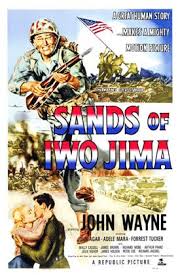
THE SANDS OF IWO JIMA
US, 1949, 109 minutes, Black and white.
John Wayne, John Agar, Adele Mara, Forrest Tucker, Arthur Franz, Julie Bishop.
Directed by Alan Dwan.
The Sands of Iwo Jima is, as the title indicates, a re-enactment of the battle of the small island in the Pacific and the raising of the flag, the photo of which became an emblem for the war effort in 1945.
This is the archetypal film of John Wayne winning the war. He had appeared in a number of war films including The Fighting Seabees and They Were Expendable, for John Ford. He received an Oscar nomination as best actor (and was to win twenty years later for True Grit).
The film is tough, Wayne plays a character who is tough, a martinet whose family have left him and who exercises his severity on his troops, especially the son of a friend who was considered too soft (John Agar).
The film was written by Harry Brown and James Edward Grant. Grant, a friend of Wayne, had written a number of films for him including Angel and the Badman, Flying Leathernecks, Big Jim McLain?, Trouble Along the Way, Hondo. The film was directed by veteran Alan Dwan, whose CV includes three hundred and eighty-six films as director, from 1911 to 1961, most of them routine and genre films. This one was one of his most upmarket films.
The Battle of Iwo Jima received a great deal of attention when Clint Eastwood’s two films, Flags of Our Fathers and Letters from Iwo Jima were released to great acclaim in 2006, the battle seen from the point of view of the American as well as from the Japanese point of view.
1. Was this a good war film? The style of 1949 and of the present? The nature of the contrast, similarities? Audience response to war films now?
2. What were the major emphasis of war films in the late 40s? The status of America’s morale-boosting? John Wayne as hero?
3. What evaluation of war and its effect on people and the world did this film give? The good aspects of war and had? Fear and destruction and death? Courage and heroism?
4. How important was the visualizing and reconstruction of battles? Comment on the portrayal of the beachhead and the battle? Audience participation in these battles and helping the audience to experience and evaluate them?
5. How well did the film focus on Conway? A typical young soldier of World War II or not? Young, intelligent, educated, reacting against his parents, against tradition, chip on his shoulder yet volunteering? What insight into this type of character did the portrayal give? His response to training, comradeship, his attitude towards fear? how did the war chance him, for better or worse? His arrogance, his life being saved, his final entering into the war? Was this genuine or jingoism? The importance of his marriage and the effect on him? Of his child?
6. How did he contrast with Stryker? The older generation, the war heroes, the John Wayne type? How interesting was the character of Stryker? His toughness with the men and their training, no-nonsense attitudes, teaching the men lessons? Yet the background of his wife and child? His drinking? The clash with Thomas and Conway? The importance of the encounter with Mary, going home with her and learning something about himself? The need to talk and communicate? His response and heroism in war? The irony of his death, the reading of the letter? What values did this character stand for?
7. How important for the complexity of the war theme was the portrayal of Thomas and his trouble making? Insight into the type of trouble-maker?
8. Was the battle balanced by the romantic sequences? The real relationship between Conway and Alison? The marriage? The child?
9. How well did the film portray the men and the marines? The nature of life during war, training, the purpose of fighting, learnings versus heroism?
10. What did the film say about the nature of heroism? The ordinary man and the challenges made? The various battles, soldiers’ behaviour? Patriotism and morale with the flag? The famous flag, and its impact on America?
11. How successful was this film as a record of the impact World War II had on post-world-war ferlings?
12 Was the film a successful film of its kind?
Published in Movie Reviews
Published in
Movie Reviews
Tagged under
Saturday, 18 September 2021 19:43
Sandpiper, The

THE SANDPIPER
US, 1965, 115 minutes, Colour.
Elizabeth Taylor, Richard Burton, Charles Bronson, Eva Marie Saint, Robert Webber, Torin Thatcher, Tom Drake.
Directed by Vincente Minnelli.
The Sandpiper was a very popular film of the mid-1960s. It echoes the behaviour of Elizabeth Taylor and Richard Burton in real life on the set of Cleopatra. After that they made quite a number of films together, this being one of their first. Richard Burton again plays an Episcopalian priest – as he had done the year before in the film version of The Night of the Iguana by Tennessee Williams.
Elizabeth Taylor portrays a bohemian-style artist living on the Pacific coast. Her young son kills a deer and is sent to a boarding school. The headmaster is played by Richard Burton. His wife is played by Eva Marie Saint. Charles Bronson portrays another beatnik artist in the colony on the coast – perhaps an unlikely role for him.
The film is romantic, probes the issues of unmarried mothers, seduction, illicit affairs, fidelity and infidelity. The sandpiper is a bird who is rescued by Elizabeth Taylor. She cures his broken wing but he is unable to leave the house. Is this symbolic of the character of Richard Burton?
The film won an Oscar for its popular song, ‘The Shadow of Your Smile’. (The next year Taylor and Burton were much more aggressive towards each other in Who’s Afraid of Virginia Woolf and The Taming of the Shrew.)
1. How enjoyable was this film? Its impact,and appeal? For what audience was it intended? For popular response?
2. The title and its significance? The focus on the bird as symbol of a free soul? Laura as a sandpiper? The overtones of art and life? Nature and artificiality?
3. The contribution of the colour, Big Sur locations, the sea, beaches, the Panavision? The atmosphere of art? The music and the use of the song ‘The shadow of your smile’?
4. The quality of the film as a love story? Its tone and treatment? How serious? Popular women's fiction? The development of characters? The seriousness of the issues? The use of Richard Burton and Elizabeth Taylor in such a film?
5. The success of the film’s focus on Laura? What kind of woman was she in herself? As a woman, as a mother? Her philosophy of freedom? Her beliefs as an artist, work aad skill as an artist, her friends and her relationships with them? Cos? The freedom of her moral stances? The clash with Mr Hewitt? Her determination to seduce him? The effect of their relationship, change in her? The discovery of her capacity to hurt and be hurt? The realism of her final decisions? how well do explored was her character?
6. The character of the Reverend Hewitt? Richard Burton's style in portraying a clergyman? What kind of man was he? How religious? His beliefs and his job? His love for his wife? His belief in education? His fascination with Laura and succumbing to her? The symbolism of his collar? His friends and his relationship with Laura’s friends? The beach party and its impact? The nature of him dilemma and its visual portrayal? What hold did Laura have on him? His decision to tell the truth? His sermon? hurting other's and his final decisions? Was he right to go off? What future would he have?
7. The contrast of Clare with Laura? A loving wife, involved in the schooling, focus on fundraising? her interest in education and in Danny? Her inability to see the truth? The hurt when she discovered the truth? The violence emotionally at the discovery of the truth? Her future with Hewitt?
8. The film’s comment and portrayal of Californian society? the school, the artists, the school board, Ward Hendrix and his moral horizons?
9. The discussions, the film of theories of family, children, education (for example the views of Judge Thompson)? How interesting and relevant to the love story?
10. The insight into the nature of marriage and love? The formalities of love and marriage?
11.The theme of judgment and casting stones? The religious background of the film?
12. Many critics said the film was phoney at thetime? how does the film stand up decades later?
Published in Movie Reviews
Published in
Movie Reviews
Tagged under
Saturday, 18 September 2021 19:43
Sanders of the River
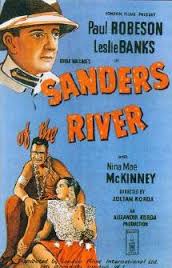
SANDERS OF THE RIVER
UK, 1936, 98 minutes, Black and white.
Leslie Banks, Paul Robeson, Nina Mae McKinney?.
Directed by Zoltan Korda.
A production by Alexander Korda of the mid-thirties and was directed by his brother Zoltan Korda. They were responsible for many quality films for the British industry during this period like Four Feathers.
The film is significant for having Paul Robeson in the central role of Bosambo. He has a strong presence, confident and, of course, a great singer. Leslie Banks is rather colourless as Sanders. Looking at times very much like a silent film or an imitation of a Robert Flaherty documentary, the film reflects very strongly the colonial atmosphere of the thirties and the decades before and concepts of Empire run by the British civil servants. Its attitude towards Africa and the Africans would be strongly questioned in succeeding decades. It reflects the atmosphere of the times. The film was based on a story by Edgar Wallace. This was adapted and used as the basis for a thriller about diamond smuggling in the 60's and was called Coast of Skeletons, starring Richard Todd. It does not compare with the original.
1. An entertaining African story? Historical interest, reflecting the British Empire attitudes of the times - towards Empire, towards the native Africans, towards government and rule?
2. The conventions of the African adventure? The white rulers, the African Chief, the villains, presentations of primitive life, warfare? Dangers and crises? Conventional material - the styles of the thirties? How do they seem now?
3. The black and white photography, the use of African locations and atmosphere? The importance of the score? the songs and the song about Sandi, and the battle song? Paul Robson's singing?
4. How does the plot seem in retrospect? The picture of the presence of the British in Africa, the public servants and their administration, their view of themselves as rulers and administrators with rights over the Africans? The benign aspects of this? Bad aspects? Patronizing aspects? The relationship between blacks and whites? The presentation of the black tribes under this administration, their way of life, presented as primitive? Warfare? The hero and the background of his being in prison, his being acceptable to the administration and becoming Chief? Marriage, child? Working for the British? The kidnapping of his wife and his final heroism? How contrived, how realistic?
5. Paul Robeson and his presence on the screen, personality, singing? Credible as an African prisoner turned Chieftain? His impact with Sanders and the white administration? Their making him King, his establishing himself, enmities, service of the British? The significance of his song in praise of Sanders? His heroism, ordinary life, training his young son? Love of his wife? His York for Sanders and helping him at the end but moving towards his vife? The rescue and the happy ending? How credible a character was Bosambo - a hero of fiction rather than real lift?
6. Lilango and her presence, love for Bosambo, marriage, training of her child, attitude towards the white administration, her kidnapping, heroism, rescue?
7. Sanders as hero? The film and its praise of the white administration? His attitudes, treatment of Bosambo, relationship with his colleagues, with the Africans, his illness and the rumours with the destructive consequences, his reappearance, his going to the rescue of Lilango? Sanders as hero?
8. The white administration with their strengths and weaknesses? The African Chieftains and their aims and purposes?
9. The scenes of warfare? Bosambo and his rousing his men with his song? The old Chieftain and his men? The clashes? The torture and the deaths at the end?
10. The style of the film? echoes of the silent treatments: the captions and introductions, the episodic nature of the film? How satisfying was the overall presentation, the happy ending?
11. The presentation of colonial and empire attitudes and their being taken for granted in the thirties? The strengths and weaknesses of this system? The assumptions of the British, the treatment of the Africans? How has this changed in the succeeding decades? For the better? Or not?
Published in Movie Reviews
Published in
Movie Reviews
Tagged under